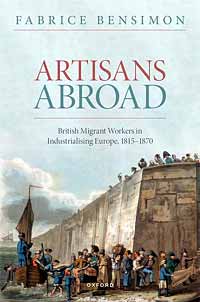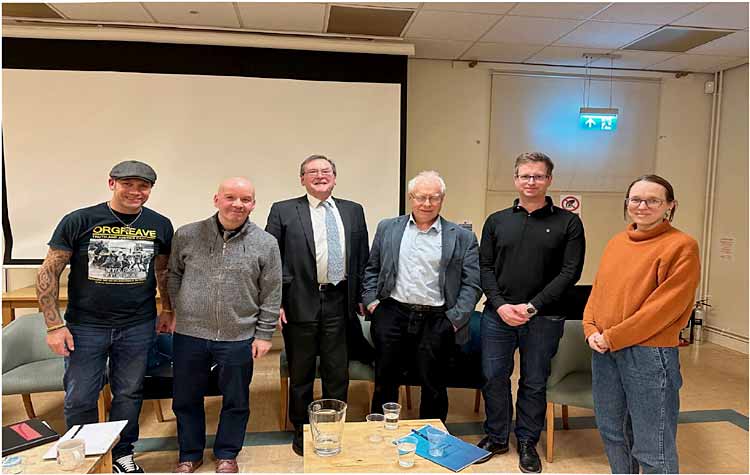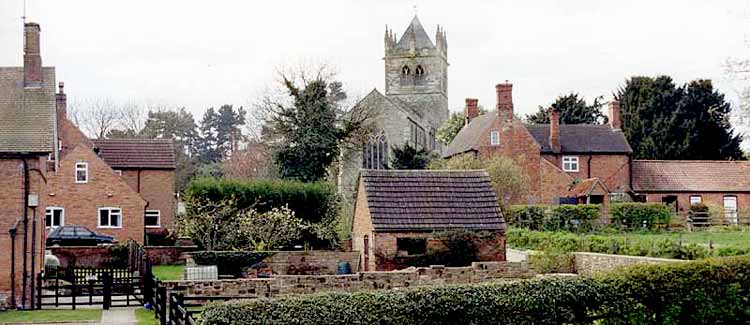Events during Spring 2024
The Rosalys Coope Lecture: 10th February 2024
THE EMIGRATION OF NOTTINGHAMSHIRE LACE MAKERS TO CALAIS IN THE NINETEENTH CENTURY : BRITISH MIGRANT WORKERS IN EUROPE (1851-1870)
Fabrice Bensimo, University College, London
 The issue of migration is never far from the news these days, but the focus is usually on incoming settlers to Britain rather than those wanting to leave this country in the hopes of finding a better life abroad. Between 1815 and 1870, thousands of British artisans emigrated to the European continent, including hundreds of skilled lace makers from the East Midlands. They ended up forming a distinctive community within northern France, especially at Calais, which became the centre of the domestic lace industry in France. With their knowledge of bobbin-net technology, the British emigres had a competitive edge which allowed them to sell their goods into French markets without the imposition of taxation or the dangers of smuggling.
The issue of migration is never far from the news these days, but the focus is usually on incoming settlers to Britain rather than those wanting to leave this country in the hopes of finding a better life abroad. Between 1815 and 1870, thousands of British artisans emigrated to the European continent, including hundreds of skilled lace makers from the East Midlands. They ended up forming a distinctive community within northern France, especially at Calais, which became the centre of the domestic lace industry in France. With their knowledge of bobbin-net technology, the British emigres had a competitive edge which allowed them to sell their goods into French markets without the imposition of taxation or the dangers of smuggling.
Many emigres maintained close connections with the East Midlands and, on occasion, they found themselves subjected to suspicion and hostility in their adopted homeland - the eternal lot of the migrant. With a wide range of apt and engaging commentaries, helpfully translated into English, Fabrice Bensimo gave members a fascinating insight into this hitherto neglected aspect of the impact of the East Midlands lace makers on their European neighbours.
The Society is grateful to Fabrice for making his own substantial trek from Paris (where he teaches) to Nottingham for the purposes of giving the lecture, which generated a wide range of questions from the audience. Anyone interested in reading the fruits of his research can do so for free by downloading his recently published monograph from the link as shown below: global.oup.com/academic/product/artisans-abroad-9780198835844?cc=pl&lang=en& (click the open access symbol above the advertised price and download as a PDF file).
Richard A. Gaunt
The Norah Witham Lecture:
9th March 2024
VIKINGS IN YOUR VOCABULARY
Professor Richard Dance (St Catharine's College, Cambridge)
This was the last contribution to the Society's 2023-4 winter lecture programme, and it was originally timed for March 2020. The delay had, of course, fallen foul of the restrictions imposed as a consequence of the COVID outbreak. Fortunately, Professor Dance, who is Professor of Early English in the Department of Anglo Saxon, Norse and Celtic was willing to come again, and he attracted a full house including members of the Centre for Viking Studies at the University of Nottingham. Local history was once primarily about documents, but since the Second World War it has gradually expanded to incorporate archaeology and antiquities, and now into a range of other disciplines. One of those is language as a way of helping us to understand the past and in particular the places in which we reside.
The Thoroton Society has had lectures on family names and place names in the past, and from Professor Dance's lecture we have now learnt about other forms of communication, namely Old English, Old Norse, and Middle English. Viking words? They come from Old and Middle English.The lecture was about the three languages of the Vikings. Old English - the English of Pre-Conquest England c480-1100; Old Norse - the languages of the medieval Scandinavians ('the Vikings' (c700 - 1500 and the English of the later Middle Ages (c1100 - 1500).
Professor Dance showed us letters and pronouncements by comparison with Modern English. Then he talked in OE and ON, and got us all speaking in the same language! He assured us that we would have been able to communicate because there were sufficient common letters but it was not always easy to appreciate! The emphasis was on the influence of Vikings coming to England and the impact on existing language. He quoted the language and how it must have sounded. Audience participation made for a few minutes of fun, and the audience joined in with gusto!
Professor Dance also briefly discussed place names, including 'Thoroton' so that the audience was able to pronounce something they could already understand.lt was hard going, but Professor Dance was easy to understand and we listened attentively and posed many questions. It was a bit different from a 'normal' Thoroton lecture but informative, entertaining and challenging - and well worth waiting four years for it to be given.
John Beckett
Please note that some recommended reading given by Professor Richard Dance is listed below:
The Gersum Project: www.gersum.org
S Armitage, trans., The Death of King Arthur (Faber, 2012)
P S Baker, Introduction to Old English (Blackwell 2003)
D Crystal, The Cambridge Encyclopedia of the English Language (Cambridge, 1995)
E V Gordon, An Introduction to Old Norse, 2nd ed, rev. A R Taylor (Oxford, 1957)
S Horobin, How English became English. A Short History of a Global Language (Oxford 2016)
B Mitchell and F C Robinson, A Guide to Old English, 8th ed (Blackwell, 2011)
L Mugglestone, ed, The Oxford History of English (Oxford 2006)
J R R Tolkien, tran., Sir Gawain and the Green Knight, Pearl and Sir Orfeo, ed C Tolkien (Allen and Unwin, 1975)
M Townsend, Language and History in Viking Age England: Linguistic Relations between Speakers of Old Norse and Old English (Brepols 2002)
THE LEGACY OF THE MINERS STRIKE 1984/1985
Report on the 21st March Event, 2024

With John Hess, former Political Editor, BBC East Midlands and a Thoroton Society Member chairing this evening, the meeting was both enlightening and a trip down memory lane for the audience. The panel consisted of two former miners from the 1980's, Dr David Amos, now a Community Historian and Mr Ken Bonsall, now a Musician, and the historians Robert Gildea, Emeritus Professor University of Oxford, Dr Jorg Arnold, University of Nottingham and Dr Florence Sutcliffe-Braithwaite, University College London, (see photograph on the back cover of this Newsletter). All contributed to the evening by their first-hand knowledge and their research and the text below is from my notes taken from our panel's contribution and reflections on the many voices in the dispute. The panellists drew on many different elements of the story of this dispute, (not all of them) but through their own combined recollections the audience gained a good deal about this defining moment in the history of coal mining in the UK. The 1984 Miner's strike was a 'Political Battle' between one side of society and the other. As John Hess said in his introduction the miners' strike of 1984 was a turning point in Coal Mining History. Miners left their pits to fight the Thatcher Government, who were trying to break the Miners' Union and the labour movement. The battle cry of 'Close the pit, kill a community' is remembered by many. The miners, powerfully backed by their wives, were sure that without the pit, there was little future for their children. Wives, girlfriends and the older generation gave unlimited support to the men. The points raised and the discussion by the panel with the questions that followed led to many points being covered. The following paragraphs allow a record of a variety of very personal views of this defining moment in the history of UK coal mining.
It was highlighted by all the panel that the Nottingham NUM supported the strike but a majority of its workers continued to work and many of them considered the strike to be unconstitutional. The miners, despite the hostility, opted to keep working, allowing Nottinghamshire to become the hub of the anti- strike movement.
The strike began on 6th March 1984, after officials had revealed plans to close pits and put up to 20,000 miners out of work. All the panel confirmed that the Nottinghamshire Coalfield was very significant as it bordered the Yorkshire Coalfields and became a front line, dividing communities, dividing families and dividing the Union. This point was reiterated by a number of the panel. The strike breakers and their wives and families in Nottinghamshire were to be despised nationally by miners who refused to strike. But in mining villages , wives and daughters of the men on strike were united and many of their organisations provided food, food parcels, moral support and were often on the picket line alongside their men. Women were also arrested and went to prison because of their support for the men.
So the very important support of the women was highlighted by all the panel. The development of women support groups and how the women were drivers of change with the pits closing and the textile industry declining was used to show how this deindustrialisation shaped the women's lives.The importance of the Nottingham mines was also highlighted and how in 1984 North Nottingham mines were profitable and feeding the power stations.
The misconception in 1984 that two of the pits were due to close and the differences between production and the industrial relations in North Nottinghamshire mines and South Nottinghamshire mines was also mentioned. The deindustrialisation and the effects on the mining community after the closures was highlighted. As put by Ken Bonsall, the knock on effect of the pit closing was slow motion suicide. He used the demise of Eastington Pit Village as an example and the social changes that took place, the knock on effects to shops, drug related problems and how this coal mining strike lead quickly to closure of most of the coal mines and how after the strike a general deindustrialisation of the economy and privatisation of industries took place.
The panellists showed that just as the miners had warned with their slogan 'Close a pit, kill a Community' unemployment and poverty in the former mining areas became a reality. This panel, with their own history and their variety of memories of the strike, allowed the audience to gain first hand, a variety of viewpoints, of the miners' strike and to reinforce and even change their own recollections of 1984/1985. They confirmed that the defeat of the strike led very quickly to the decline of coal mining, yet out of the strike came the miners and their wives' survival, as they returned to other jobs and developed different skills allowing them to reinvent their lives. While the pits had closed the heritage of mining has survived, as was shown by the panel.
At the end of this excellent, instructive and historical evening we were delighted that Sarah Wimbrush, poet and author of the poetry book 'STRIKE' read two of her poems.
A wonderful historical evening that allowed all present to be back in 1984/1985 and recognise from the panel's contributions, the various sides and views of this bitter strike.
Paul Baker (Rapporteur)
EXCURSION REPORT
Report on the Thoroton Society visit to Laxton on 16th May 2024

Laxton or as it often appears in historical documents, Lexington, dates from before William the Conqueror invaded England. It was a Roman settlement built in the area between the first and fourth century. There is later evidence of Anglo Saxon Laxton, and Danish influence can be found through the agricultural terminology. Field names suggest that much of the area was once woodland, clearance must have taken place in the early Middle Ages. The Domesday entry suggests that about 720 acres of arable and over 40 acres of land provided pannage (acorns and beechmast) for pigs, fuel and timber for building.
It was therefore an obvious location for the Thoroton Society members to make a historical visit to a village with so much interesting history and for some to visit with Laxton again after a number of years of absence. Despite the rain it turned out to be a very instructive day thanks to John Beckett and Stuart Rose who gave us a great deal of both historical and present history of Laxton.
We arrived to a warm welcome from John and Stuart and in the visitor centre and we were given a full history of the village which in Medieval times was very prosperous, of what survives of the Medieval motte and bailey castle, the open field farming, how this survives in Laxton today. Stuart explained to us about the rotation of the crops, how the farming year was planned and how farmers in the past, and even today, follow an annual farming cycle. The ploughing with horses has today been replaced by the tractor and plough, but the traditional farming methods are still evident. Stuart explained about the inspection by the jury and Jury Day and the Court Leet. How the field boundaries were inspected and the Courts functions.
Stuart was also able to show why the open field farming has survived enclosed. The history of Laxton was fully covered and after the most interesting history lesson on this open field farming there was more to come as we walked to the church where we learnt about the Medieval prosperity. The church has been in Laxton since 1190and since then has been built in phases. The present chancel where we gathered to hear from Stuart, its history dates from the 14th century. Here we were brought up to date with its history and present day usage. Over the centuries there have been many changes to its structure, and Stuart was able to tell us about a wide variet ofthe changes that have taken place and its importance today to the people and the village today.
It was then time for lunch at the Dovecote, and we all enjoyed some excellent food and drink .The pub is usually closed on a Thursday but it had opened for us and we all thoroughly enjoyed our meal. After lunch, with the rain still falling heavily, it was decided that rather than walk in the rain, the coach would drive us to a few locations where Stuart could point out and explain various aspects of the farming methods and how since the early twentieth century the emphasis has moved from enclosure to preservation. Through the driving rain, we were still able to gain a great deal of the history of Laxton. This was well worth the visit despite the rain and with the expert guiding and knowledge given to us by Stuart Rose supported by John Beckett, it is an excursion which will be long remembered.
I do hope that other members of the Thoroton society will visit Laxton.
Paul Baker
Postscript
David James was in contact with me from the USA when he saw that we were having an excursion to Laxton and below is the information from his work he sent me.
Laxton Projects
David E James
See: en.wikipedia.org/wiki/Laxton,_Nottinghamshire
Completed
1. "Agricultural Revelation: Land, Labour, and Voice in Three Films About Laxton"
Essay about how the films made about Laxton in 1935, 1975 & 1981 reflected the state cf the village and its current crises.
Moving Image Review & Art Journal [MIRA]), 7:1. (2018), 1-22,
Rpt., David E James, Power Misses II: Cinema, Asian and Modern (London: John Libbey Publishing, and Bloomington: Indiana University Press, 2021)
2. "Laxton: Some Views by David E James and Mike Jackson"
short on-line essay on some agricultural features cf Laxton, with photographs
The Clearing (2022 i 31):
www.littletoller.co.uk/the-clearing/laxton-some-views-by-david-e-james-and-mike-jackson/
3. A Man's Destination (65-minute digital film, 2019)
I selected 24 locations in Laxton, most of them in the open fields and all having some specific topographical, agricultural or historical interest. Keeping the framing consistent, I photographed each of them four times over a year on each of the solstices and equinoxes, beginning in fall 2016. The film is formed from 20 seconds of each shot with a lap dissolve between them, thus creating 24 sequences showing the locations, the landscape, the crops and the weather as they change over the year. The soundtrack consists of the childhood recollections of a woman who grew up in Laxton in the 1920's and who, at the time of the recording, was the oldest living person born there. The film is designed for both single projection and as an installation.
Formatted as high-res Apple ProRes 422.mov, and low-res Quicktime using the H264 codec. On deposit at Nottinghamshire Archives
In Progress
4. Laxton: The Survival of an Ancient Village: a collection of photographs with texts and an introduction.
I have been photographing the landscapes of Laxton since 2008 and now have about 10,000. I have agreed to deposit these eventually at the Nottinghamshire Archives.
David James
Laxton Researcher from USA